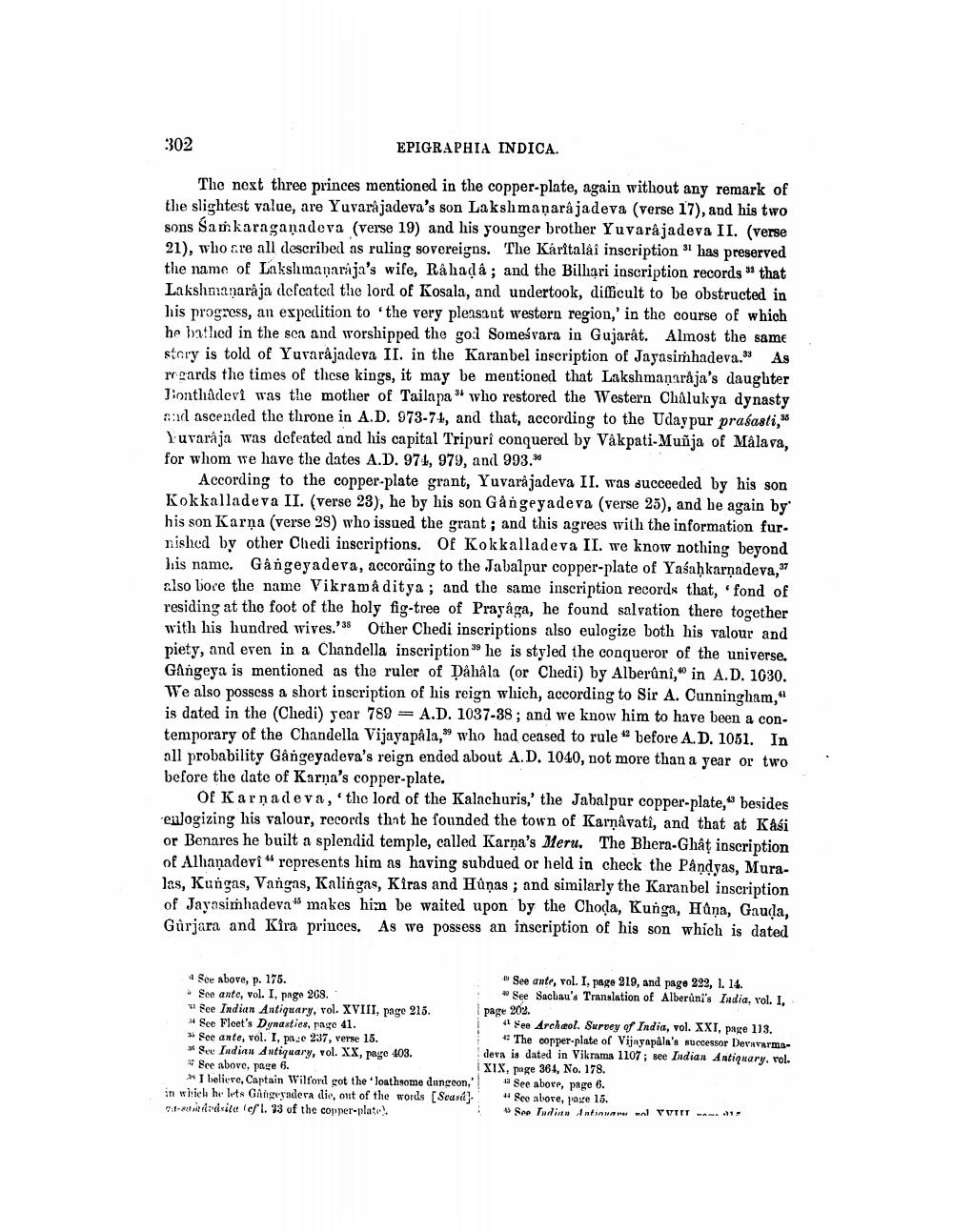________________
302
EPIGRAPHIA INDICA.
The next three princes mentioned in the copper-plate, again without any remark of the slightest value, are Yuvara jadeva's son Lakshmanarâ jadeva (verse 17), and his two sons Sarkaragamadeva (verse 19) and his younger brother Yuvarajadeva II. (verse 21), who are all described as ruling sovereigns. The Karitalai inscription 31 has preserved the name of Lakshmanaraja's wife, Rå hadá; and the Billari inscription records that Lakshmanarâja defcated the lord of Kosala, and undertook, difficult to be obstructed in his progress, an expedition to the very pleasant western region,' in the course of which he bathed in the sca and worshipped the goi Somešvara in Gujarat. Almost the same story is told of Yuvarajadeva II. in the Karanbel inscription of Jayasimhadeva. As regards the times of these kings, it may be mentioned that Lakshmanaråja's daughter Lionthaderi was the mother of Tailapa " who restored the Western Chalukya dynasty ad ascended the throne in A.D. 973-74, and that, according to the Udaypur prasasti, Yurarâja was defeated and his capital Tripuri conquered by Våkpati-Muñja of Málava, for whom we have the dates A.D. 974, 979, and 993.
According to the copper-plate grant, Yuvara jadeva II. was succeeded by his son Kokkalladeva II. (verse 23), he by his son Gangeyadeva (verse 25), and he again by his son Karņa (verse 29) who issued the grant; and this agrees with the information fur. nished by other Chedi inscriptions. Of Kokkalladeva II. we know nothing beyond liis name. Gångeyadera, according to the Jabalpur copper-plate of Yaśaḥkarnadeva, 37 also bore the name Vikram å ditya ; and the same inscription records that, fond of residing at the foot of the holy fig-tree of Prayaga, he found salvation there together with his hundred wives.'38 Other Chedi inscriptions also eulogize both his valour and piety, and even in a Chandella inscription" he is styled the conqueror of the universe. Gangeya is mentioned as the ruler of Dåhâla (or Chedi) by Alberûnî," in A.D. 1030. We also possess a short inscription of his reign which, according to Sir A. Cunningham," is dated in the (Chedi) year 789 = A.D. 1037-38; and we know him to have been a contemporary of the Chandella Vijayapala, who had ceased to rule * before A.D. 1051. In all probability Gangeyadeva's reign ended about A.D. 1040, not more than a year or two before the date of Karna's copper-plate.
Of Karnadeva, 'the lord of the Kalachuris,' the Jabalpur copper-plate," besides enlogizing his valour, records that he founded the town of Karņavatî, and that at Kasi or Benares he built a splendid temple, called Karna's Meru. The Bhera-Ghât inscription of Alhanadevi" represents him as having subdued or held in check the Pandyas, Muralas, Kungas, Vangas, Kalingas, Kiras and Hûņas; and similarly the Karanbel inscription of Jayasimhadeva" makes him be waited upon by the Choda, Kunga, Hana, Gauda, Gurjara and Kira princes. As we possess an inscription of his son which is dated
See above, p. 175.
See ante, vol. I. page 219, and page 222, 1. 14. Sce ante, vol. I, page 268.
* See Sachau's Translation of Alberůni's India, vol. I, Bee Indian Antiquary, vol. XVIII, page 215.
page 202. # See Fleet's Dynasties, rage 41.
"Seo Archeol. Survey of India, vol. XXI, page 113. * See ante, vol. I, p. 237, verse 15.
The copper-plate of Vijayapala's successor Dernvarma* See Indian Antiquary, vol. XX, page 403.
dera is dated in Vikrama 1107; see Indian Antiquary, rol. See above, page 6.
XIX, page 361, No. 178. I beliere, Captain Wilford got the loathsome dungeon,'! See above, page 6. in while he lets Gangeyadera die, out of the words [Sousd). "See above, ose 15. Out- d ila lef I. 33 of the copper-plate
- See Twinin Intinua l VVTIT . .




